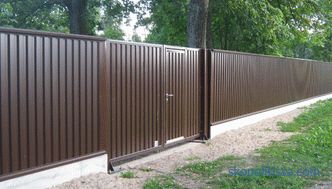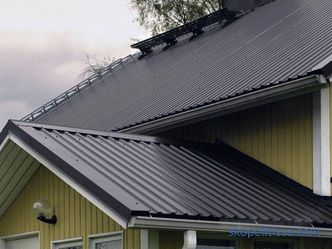There are many reasons why a house has to be built on a plot with high groundwater. But the consequence is always the same - if you do not equip the protection against flooding, then every spring the water will arrive at the site, washing away the soil, the foundation and the basement of the house.
A properly installed drainage system and storm sewers can help solve the problem. If you know about the level of groundwater at the stage of buying a plot, then it is most advantageous to plan the arrangement of drainage and storm water along with the construction of the house itself. In such cases, you can save money and do the drainage and drainage in one trench.
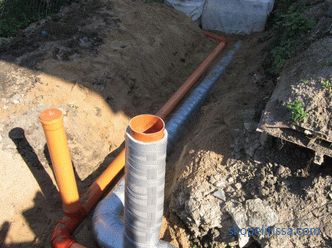
Why do we need drainage and storm sewers
The main task of the stormwater (ie, the storm system) is to collect with the help of interconnected gutters and pipes, water from the roof - rain or thawed. The ravine consists of two parts — the outer (gutter under the roof) and the underground (receivers and pipes that divert water from the house). In the part that is in the ground, water from the roof and blind area, and then removed from the site.
Drainage drainage is needed in order to collect excess water from the ground, i.e. drain it. The main task of drainage is to prevent the rise of groundwater levels, to prevent flooding of the site.
Since both systems provide for the removal of water into special drives, the combined scheme of drainage and stormwater operation looks very attractive in terms of functionality and economy. Collected water can be used for technical purposes, for example for irrigation.
This is important! "In one trench" does not mean that the same pipes are used for drainage and for drainage. Such a scheme is strictly forbidden for the reason that during seasonal increases in rainfall the stormwater is systematically overfilled. If the same pipe will work as a drainage, then at best, the drainage will temporarily stop functioning.
Drainage and storm sewers: the varieties of these systems and their features
Systems have a completely different structure, only pipes and wells are of similar elements. At the same time, they differ not only in structure, but also in the method of installation.
Drainage drainage (closed type)
Located only underground, respectively, refers to the closed type of sewer systems. The only elements that are partially located above the surface are wells.
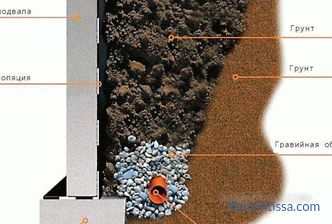
There are several factors that determine whether a drainage system is needed at a site or not. It is made in such cases:
-
if the aquifer is sufficiently high on the site;
-
the soil is clay or loamy;
-
in the area where the site is located, floods often occur;
-
a buried foundation is settled;
-
the site is located in a valley.
If one of these conditions is fulfilled, then most likely, without drainage, there will be problems with flooding or increased humidity of the basement and the foundation.
The drainage system consists of the following elements:
-
Drains (drainage pipes for sewage made of geotextiles and having perforations through which water enters the drainage).
-
Sand traps (do not allow pipes to clog with frequent sludge and sand).
-
System Drainage . Conducts cleaned from silt and sand water directly into the drainage wells.
-
Several types of wells .
After the wells, where the water is cleaned, it gets into the shared storage tank, and then either is used for personal needs, or is discharged into the waste system.
The materials from which drains are made :
-
Plastic . Durable, not very expensive, very strong and resistant to low temperatures.
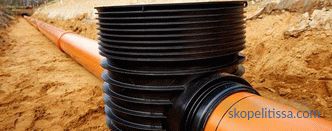
On our site you can find contacts of construction companies that offer the service of design and installation of water supply and sanitation. Directly to communicate with representatives, you can visit the exhibition of houses "Low-rise Country".
-
Asbestos cement . Cheap, but very short-lived - in a few years growths may appear on asbestos-cement pipes.
-
Ceramics . Before the advent of plastic, ceramics were the best option
Standards pipes:
-
SN marking 2-4 (depth up to 3 x meters);
-
marking of SN 6 and what goes above for depths of up to 5 meters.
An example of the arrangement of the drainage system is shown in the video:
Storm sewers (open type)
"Livnevka" consists of two parts - the top and bottom. The system includes:
-
gutters into which water gets from the roof, and which lead it further;
-
funnels and vertical pipes . Water gets into the funnels and then, through vertical pipes, into the lower part of the "stormwater";
-
clamps to strengthen the pipes when they are connected;
-
tees and rotary knees that connect horizontal and vertical pipes to each other, a funnel can also be attached there;
-
wells .
The system is assembled as a designer, it is necessary to make a system drawing, carefully fasten the parts and get the storm sewer ready.
The most commonly used gutters are materials :
-
galvanized iron;
-
copper;
-
ceramics;
-
plastic (PVC).
From which the stormwater will be made, is selected depending on the device of the house, its architecture and the material of which the roof is made. It is possible to supplement the gutters with nets and an anti-icing cable so that in the spring the ice does not block the water outlet.
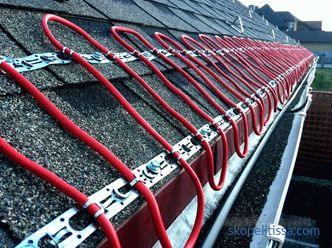
For the manufacture of intermediate and main wells use the following materials:
-
PVC (an expensive but very effective option);
-
Brick and stone (durable, but should be properly assembled) ;
-
Rings from reinforced concrete (difficult to install);
Their design is exactly the same as that of closed drainage.
It may be interesting! In the article on the following link read about the varieties and features of the drainage area.
Combination of storm and drainage sewers
The whole system is installed in one trench. The scheme of drainage and storm sewage in the area is quite simple. Through the nodal tee, water from the outside and from the inside (precipitation and groundwater) will flow into the drainage well.
Drainage pipes pass through the entire section, collect water, and then it is discharged into wells, where it is pumped out of the area by a pump. In the "stormwater" water is collected and discharged into the collector drain, after which, through the above-mentioned well, it enters the trunk pipe system that exists autonomously from drainage, but in one trench (no perforation is necessary for the storm system). Through the system of trunk pipes, water enters the bypass well, in which, like in the drainage, it is pumped out.
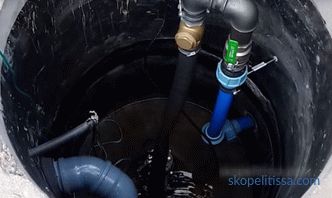
The connection of the storm and drainage systems is very advantageous, only a wide trench is required; all that is needed is to designate a place for a branch line in which water from both systems will follow different paths so that they are not overloaded.
Through the node tee, water from the outside and from the inside (precipitation and groundwater) will flow into the drainage well.
The principle of operation of drainage and storm sewers
Storm sewers: point drainage. Dot elements are necessary for collecting precipitation, be it rain, melting snow, melted hail. Water can be sent along the gutters to the drainage system, and then sent to special ditches with grates, along which water will be removed from the site. It is very important when the building is located on a slope, as when choosing the right angle, you will not need to build additional gutters, but take the water directly into the ditches.
With a linear drainage system, water is drained through the gutters and funnels into a special trunk system consisting of pipes that are suitable for drainage and storm sewers. Further along this main system, the sewage flows into the collector, and then, depending on the project, the water can go to the reservoir, and maybe for the site.
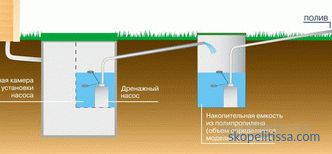
Under deep drainage, water from the rising groundwater is gradually discharged in separate parts into the well, and from there it is pumped out and pumped out. Such a system has 3 types:
-
Horizontal;
-
Vertical;
-
Wall. If there is a basement or basement in the house, it is required to discharge groundwater from them. Wall drainage is most effective: a moisture receiver is arranged close to the walls, and the wall itself is thoroughly waterproofed.
It may be interesting! In the article on the following link read about drainage around the house.
Care and maintenance regulations
Both systems require regular inspection and cleaning of sludge, sand, clay and other debris.Seasonal inspections are required - at the end of autumn, when the rainy season ends and at the end of winter, to make sure that the water-carrying capacity is not disturbed. Despite the various filters, sand traps and mesh trash, dirt still gets inside. They are everywhere: in pipes, gutters and wells. In the absence of care, the system will simply clog and stop functioning.
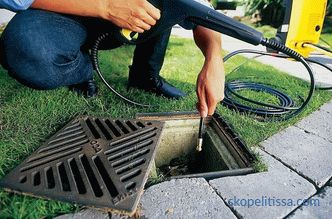
To clean the pipe it is enough to turn on the pump to maximum power and run through the pipes of ordinary water from a hose, it will collect all the dirt and bring in the well. Water can be poured into the gutters and it will also collect all the dirt and then go along vertical pipes. The stronger the pressure, the more dirt and debris will go.
Already in the pump all the water is pumped out with an even more powerful pump or suction pump, when all the water runs out, it will be necessary to clean the walls. Most often, this ends with flushing, but if the system has not been maintained for a long time, it happens that you have to manually, using a scraper, clean the walls and bottom of the well. Therefore, regular cleaning is necessary for both systems to work stably.
Rules for installing a dual system
Proper installation of a combined system is necessarily carried out according to a previously created project, which specifies the nuances concerning the binding to the site and the synchronization of the work of the wells, so that the drainage and "stormwater" work both in normal mode and when overloaded.
When installing, it is necessary to consider the following nuances:
-
The arrangement of the drainage system is a rather expensive pleasure. If something goes wrong and after a few years the drainage will stop working, then it will have to spend on its restoration no less than to spend on a new one, especially considering that it is necessary to “scratch” the landscape design. As a result, the arrangement of drainage should be done by professionals.
-
During the flood period, each of the systems will be overloaded. Since they collect moisture from different sources, then the drains must be laid for each system separately. You can do this in the same trench, but at different depths. Well to collect water can be used in common.
-
When digging trenches for drains, you should definitely take into account that the bottom of the pit will be covered with rubble and sand. This means that if it is necessary to place the drains at a certain depth, the pit should be dug deeper by the thickness of the layers of sand and rubble.
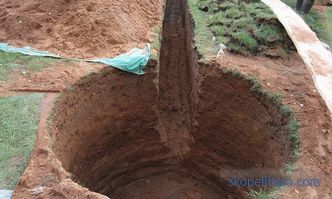
-
Usually water it is collected in a reservoir (pit or reservoir), from where it is used for technical needs or pumped into reservoirs or simply away from the site. If perforated pipes are used for drainage, the outlets are always solid. When combining them in the same trench vertically, perforated are placed on the bottom, and usual on top.
-
If in the trench the pipes of the main line and the drains are aligned horizontally, then they are laid in parallel, at a short distance from each other (so that if the main pipe is damaged, water does not fall from there into the drainage system and did not overload it).
About the installation of the stormwater system and drainage in the following video:
It might be interesting! In the article on the following link read about drainage pipes.
Conclusion
The combined drainage and storm sewage system is not only an effective way to get rid of the flooding of the site, but also a fairly profitable offer, as it will simplify the system and save money on purchasing many additional elements. It turns out that the integrity of the foundation will be preserved and money will be saved on waterproofing and arranging both sewers separately.



